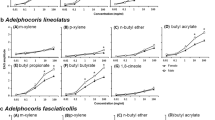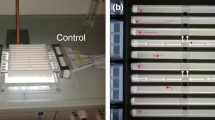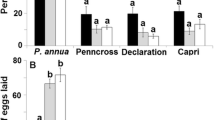Abstract
Lygus hesperus Knight is a polyphagous pest of major concern to numerous cropping systems across western North America. Lygus hesperus exhibits well-documented host preferences which may be used to develop behavioral management strategies for this pest. This study sought to identify plant volatiles that mediate L. hesperus host preferences and assess the potential of those compounds to improve monitoring and management of this pest. Gas chromatography with electroantennographic detection was applied to identify antennally active compounds in headspace extracts from four host plants of varying attractiveness. Y-tube olfactometer assays were then conducted to determine L. hesperus responses to each of these 17 antennally active compounds individually. Six compounds attracted female L. hesperus, and subsequent tests revealed that females were attracted to an equal-parts blend of these six attractive compounds versus clean air, and that this blend was as attractive as flowering Medicago sativa. We then examined L. hesperus attraction to attractive compounds individually and an equal-parts blend of five attractive compounds in the field. An equal-parts blend of five attractive compounds was tested in strawberry, whereas the blend and each individual component were tested in alfalfa. In both field settings, neither the individual compounds nor the blend increased L. hesperus capture rates compared to unbaited control traps. Low attraction in the field could result from a masking effect of background volatiles or the failure to include important compounds in tested blends. It remains important to assess whether the compounds tested in this study may facilitate L. hesperus management in other cropping systems.



Similar content being viewed by others
Data availability
The data that support the findings of this study are available from the corresponding author, MCH, upon request.
References
Ameye M, Allmann S, Verwaeren J, Smagghe G, Haesaert G, Schuurink RC, Audenaert K (2018) Green leaf volatile production by plants: a meta-analysis. New Phytol 220(3):666–683. https://doi.org/10.1111/NPH.14671
Barlow VM, Godfrey LD, Norris RF (1999) Population dynamics of Lygus hesperus (Heteroptera: Miridae) on selected weeds in comparison with Alfalfa. J Econ Entomol 92(4):846–852. https://doi.org/10.1093/jee/92.4.846
Baroffio CA, Sigsgaard L, Ahrenfeldt EJ, Borg-Karlson AK, Bruun SA, Cross JV, Fountain MT, Hall D, Mozuraitis R, Ralle B, Trandem N, Wibe A (2018) Combining plant volatiles and pheromones to catch two insect pests in the same trap: examples from two berry crops. Crop Prot 109:1–8. https://doi.org/10.1016/j.cropro.2018.02.025
Bates D, Mächler M, Bolker BM, Walker SC (2015) Fitting linear mixed-effects models using lme4. J Stat Softw 67(1):1–48. https://doi.org/10.18637/JSS.V067.I01
Becher PG, Flick G, Rozpędowska E, Schmidt A, Hagman A, Lebreton S, Larsson MC, Hansson BS, Piškur J, Witzgall P, Bengtsson M (2012) Yeast, not fruit volatiles mediate Drosophila melanogaster attraction, oviposition and development. Funct Ecol 26(4):822–828
Bell WJ (1990) Searching behavior patterns in insects. Annu Rev Entomol 35(1):447–467. https://doi.org/10.1146/ANNUREV.EN.35.010190.002311
Bernays EA (2001) Neural limitations in phytophagous insects: implications for diet breadth and evolution of host affiliation. Annu Rev Entomol 46:703–727. https://doi.org/10.1146/ANNUREV.ENTO.46.1.703
Blackmer JL, Byers JA (2009) Lygus spp. (Heteroptera: Miridae) host-plant interactions with Lesquerella fendleri (Brassicaceae), a new crop in the arid southwest. Environ Entomol 38(1):159–167. https://doi.org/10.1603/022.038.0120
Blackmer JL, Cañas LA (2005) Visual cues enhance the response of Lygus hesperus (Heteroptera: Miridae) to volatiles from host plants. Environ Entomol 34(6):1524–1533. https://doi.org/10.1603/0046-225X-34.6.1524
Blackmer JL, Byers JA, Rodriguez-Saona C (2008) Evaluation of color traps for monitoring Lygus spp.: design, placement, height, time of day, and non-target effects. Crop Prot 27(2):171–181. https://doi.org/10.1016/j.cropro.2007.05.003
Blackmer JL, Rodriguez-Saona C, Byers JA, Shope KL, Smith JP (2004) Behavioral response of Lygus hesperus to conspecifics and headspace volatiles of alfalfa in a Y-tube olfactometer. J Chem Ecol 30(8):1547–1564. https://doi.org/10.1023/B:JOEC.0000042067.27698.30
Bruce TJA, Pickett JA (2011) Perception of plant volatile blends by herbivorous insects—finding the right mix. Phytochemistry 72(13):1605–1611. https://doi.org/10.1016/j.phytochem.2011.04.011
Bruce TJA, Wadhams LJ, Woodcock CM (2005) Insect host location: a volatile situation. Trends Plant Sci 10(6):269–274. https://doi.org/10.1016/j.tplants.2005.04.003
Byers JA, Fefer D, Levi-Zada A (2013) Sex pheromone component ratios and mating isolation among three Lygus plant bug species of North America. Naturwissenschaften 100(12):1115–1123. https://doi.org/10.1007/S00114-013-1113-7
Cai X, Bian L, Xu X, Luo Z, Li Z, Chen Z (2017) Field background odour should be taken into account when formulating a pest attractant based on plant volatiles. Sci Rep 7(1):1–10. https://doi.org/10.1038/srep41818
Carrasco D, Larsson MC, Anderson P (2015) Insect host plant selection in complex environments. Curr Opin Insect Sci 8:1–7. https://doi.org/10.1016/J.COIS.2015.01.014
Carrière Y, Ellsworth PC, Dutilleul P, Ellers-Kirk C, Barkley V, Antilla L (2006) A GIS-based approach for areawide pest management: the scales of Lygus hesperus movements to cotton from alfalfa, weeds, and cotton. Entomol Exp Appl 118(3):203–210. https://doi.org/10.1111/J.1570-7458.2006.00384.X
Chinta S, Dickens JC, Aldrich JR (1994) Olfactory reception of potential pheromones and plant odors by tarnished plant bug, Lygus lineolaris (Hemiptera: Miridae). J Chem Ecol 20(12):3251–3267. https://doi.org/10.1007/BF02033724
Davis TS, Landolt PJ (2013) A survey of insect assemblages responding to volatiles from a ubiquitous fungus in an agricultural landscape. J Chem Ecol 39(7):860–868
De Lacy Costello BPJ, Evans P, Ewen RJ, Gunson HE, Jones PRH, Ratcliffe NM, Spencer-Phillips PTN (2001) Gas chromatography–mass spectrometry analyses of volatile organic compounds from potato tubers inoculated with Phytophthora infestans or Fusarium coeruleum. Plant Pathol 50(4):489–496. https://doi.org/10.1046/J.1365-3059.2001.00594.X
Drier T, Foye S, Guédot C (2022) Y-tube olfactometer for entomology research. Fusion 70:2
Dunnett CW (1955) A multiple comparison procedure for comparing several treatments with a control. J Am Stat Assoc 50(272):1096–1121
Edgecomb RS, Harth CE, Schneiderman AM (1994) Regulation of feeding behavior in adult Drosophila melanogaster varies with feeding regime and nutritional state. J Exp Biol 197(1):215–235. https://doi.org/10.1242/JEB.197.1.215
Feng H, Gou C, Aimaiti D, Sun P, Wang L, Hao H (2022) Plant volatile organic compounds attractive to Lygus pratensis. Open Life Sci 17(1):362–371. https://doi.org/10.1515/BIOL-2022-0038
Fernando WGD, Ramarathnam R, Krishnamoorthy AS, Savchuk SC (2005) Identification and use of potential bacterial organic antifungal volatiles in biocontrol. Soil Biol Biochem 37(5):955–964. https://doi.org/10.1016/J.SOILBIO.2004.10.021
Fleischer SJ, Gaylor MJ (1987) Seasonal abundance of Lygus lineolaris (Heteroptera: Miridae) and selected predators in early season uncultivated hosts: implications for managing movement into cotton. Environ Entomol 16(2):379–389. https://doi.org/10.1093/ee/16.2.379
Fountain M, Jåstad G, Hall D, Douglas P, Farman D, Cross J (2014) Further studies on sex pheromones of female Lygus and related bugs: development of effective lures and investigation of species-specificity. J Chem Ecol 40(1):71–83. https://doi.org/10.1007/S10886-013-0375-Z/FIGURES/11
Fountain MT, Deakin G, Farman D, Hall D, Jay C, Shaw B, Walker A (2021) An effective ‘push–pull’ control strategy for European tarnished plant bug, Lygus rugulipennis (Heteroptera: Miridae), in strawberry using synthetic semiochemicals. Pest Manag Sci 77(6):2747–2755
Frati F, Salerno G, Conti E, Bin F (2008) Role of the plant-conspecific complex in host location and intra-specific communication of Lygus rugulipennis. Physiol Entomol 33(2):129–137. https://doi.org/10.1111/j.1365-3032.2008.00614.x
Frati F, Chamberlain K, Birkett M, Dufour S, Mayon P, Woodcock C, Wadhams L, Pickett J, Salerno G, Conti E, Bin F (2009) Vicia faba-Lygus rugulipennis interactions: induced plant volatiles and sex pheromone enhancement. J Chem Ecol 35(2):201–208. https://doi.org/10.1007/S10886-008-9572-6/FIGURES/3
Futuyma DJ, Moreno G (1988) The evolution of ecological specialization. Annu Rev Entomol 19:207–233. https://doi.org/10.1146/ANNUREV.ES.19.110188.001231
Gadenne C, Barrozo RB, Anton S (2016) Plasticity in insect olfaction: to smell or not to smell? Annu Rev Entomol 61:317–333. https://doi.org/10.1146/ANNUREV-ENTO-010715-023523
George J, Reddy GVP, Little N, Arnold SEJ, Hall DR (2023) Combining visual cues and pheromone blends for monitoring and management of the tarnished plant bug Lygus lineolaris (Hemiptera: Miridae). Pest Manag Sci. https://doi.org/10.1002/PS.7395
Glinwood R, Pettersson J, Kularatne S, Ahmed E, Kumar V (2003) Female European tarnished plant bugs, Lygus rugulipennis (Heteroptera: Miridae), are attracted to odours from conspecific females. Acta Agric Scand Sect B Soil Plant Sci 53(1):29–32. https://doi.org/10.1080/09064710310006517
Gripenberg S, Mayhew PJ, Parnell M, Roslin T (2010) A meta-analysis of preference-performance relationships in phytophagous insects. Ecol Lett 13(3):383–393. https://doi.org/10.1111/J.1461-0248.2009.01433.X
Groot AT, Drijfhout FP, Heijboer A, Van Beek TA, Visser JH (2001) Disruption of sexual communication in the mirid bug Lygocoris pabulinus by hexyl butanoate. Agr Forest Entomol 3(1):49–55. https://doi.org/10.1046/j.1461-9563.2001.00088.x
Heath RR, Landolt PJ, Dueben BD, Murphy RE, Schneider RE (1992) Identification of male cabbage looper sex pheromone attractive to females. J Chem Ecol 18(3):441–453. https://doi.org/10.1007/BF00994243
Hetherington MC (2023) Sensory ecology and behavioral management of two North American Lygus species. Dissertation, The University of Wisconsin-Madison
Ho HY, Millar JG (2002) Identification, electroantennogram screening, and field bioassays of volatile chemicals from Lygus hesperus Knight (Heteroptera: Miridae). Zool Stud Taipei 41(3):311–320
Innocenzi PJ, Hall DR, Cross JV, Masuh H, Phythian SJ, Chittamaru S, Guarino S (2004) Investigation of long-range female sex pheromone of the European tarnished plant bug, Lygus rugulipennis: chemical, electrophysiological, and field studies. J Chem Ecol 30(8):1509–1529. https://doi.org/10.1023/B:JOEC.0000042065.19044.6D
Innocenzi PJ, Hall D, Cross JV, Hesketh H (2005) Attraction of male European tarnished plant bug, Lygus rugulipennis to components of the female sex pheromone in the field. J Chem Ecol 31(6):1401–1413. https://doi.org/10.1007/s10886-005-5293-2
Jaenike J (1990) Host specialization in phytophagous insects. Annu Rev Entomol 21(1):243–273. https://doi.org/10.1146/ANNUREV.ES.21.110190.001331
Janz N, Nyblom K, Nylin S (2001) Evolutionary dynamics of host-plant specialization: a case study of the tribe Nymphalini. Evolution 55(4):783–796. https://doi.org/10.1111/J.0014-3820.2001.TB00814.X
Knudsen JT, Eriksson R, Gershenzon J, Ståhl B (2006) Diversity and distribution of floral scent. Bot Rev 72(1):1–120
Koczor S, Vuts J, Tóth M (2012) Attraction of Lygus rugulipennis and Adelphocoris lineolatus to synthetic floral odour compounds in field experiments in Hungary. J Pest Sci 85(2):239–245. https://doi.org/10.1007/S10340-012-0422-5
Kuznetsova A, Brockhoff PB, Christensen RHB (2017) lmerTest package: tests in linear mixed effects models. J Stat Softw 82(13):1–26. https://doi.org/10.18637/JSS.V082.I13
Landolt PJ, Alfaro JF (2001) Trapping Lacanobia subjuncta, Xestia c-nigrum, and Mamestra configurata (Lepidoptera: Noctuidae) with acetic acid and 3-methyl-1-butanol in controlled release dispensers. Environ Entomol 30(4):656–662
Landolt PJ, Guédot C, Hansen J, Wright L, James DG (2011) Trapping hop looper moths, Hypena humuli Harris (Lepidoptera: Erebidae), in hop yards with acetic acid and 3-methyl-1-butanol. Int J Pest Manag 57(3):183–188
Malo EA, Castrejo VR, Cruz-lo L, Rojas JC (2004) Antennal sensilla and electrophysiological response of male and female Spodoptera frugiperda (Lepidoptera: Noctuidae) to conspecific sex pheromone and plant odors. Ann Entomol Soc Am. https://doi.org/10.1603/0013-8746(2004)097[1273:ASAERO]2.0.CO;2
Martel V, Anderson P, Hansson BS, Schlyter F (2009) Peripheral modulation of olfaction by physiological state in the Egyptian leaf worm Spodoptera littoralis (Lepidoptera: Noctuidae). J Insect Physiol 55(9):793–797. https://doi.org/10.1016/J.JINSPHYS.2009.04.012
Matsui K, Engelberth J (2022) Green Leaf Volatiles—The Forefront of Plant Responses Against Biotic Attack. Plant Cell Physiol 63(10):1378–1390. https://doi.org/10.1093/PCP/PCAC117
Mueller SC, Summers CG, Goodell PB (2003) A field key to the most common Lygus species found in agronomic crops of the central San Joaquin Valley of California. https://doi.org/10.3733/ucanr.8104
Nakamura S, Hatanaka A (2002) Green-leaf-derived C6-aroma compounds with potent antibacterial action that act on both Gram-negative and Gram-positive bacteria. J Agric Food Chem 50(26):7639–7644. https://doi.org/10.1021/JF025808C
Nojima S, Linn C, Roelofs W (2003) Identification of host fruit volatiles from flowering dogwood (Cornus florida) attractive to dogwood-origin Rhagoletis pomonella flies. J Chem Ecol 29:2347–2357
Nout M, Bartelt RJ (1998) Attraction of a flying nitidulid (Carpophilus humeralis) to volatiles produced by yeasts grown on sweet corn and a corn-based medium. J Chem Ecol 24:1217–1239
Pansa MG, Tavella L (2009) Alfalfa management affects infestations of Lygus rugulipennis (Heteroptera: Miridae) on strawberries in northwestern Italy. Crop Prot 28(2):190–195. https://doi.org/10.1016/j.cropro.2008.10.006
Pareja M, Qvarfordt E, Webster B, Mayon P, Pickett J, Birkett M, Glinwood R (2012) Herbivory by a phloem-feeding insect inhibits floral volatile production. PLoS ONE 7(2):e31971. https://doi.org/10.1371/JOURNAL.PONE.0031971
Parys KA, Hall DR (2017) Field evaluation of potential pheromone lures for Lygus lineolaris (Hemiptera: Miridae) in the mid-South. J Insect Sci. https://doi.org/10.1093/JISESA/IEW109
R Core Team (2022) R: a language and environment for statistical computing. R Foundation for Statistical Computing, Vienna
Riffell JA, Shlizerman E, Sanders E, Abrell L, Medina B, Hinterwirth AJ, Kutz JN (2014) Flower discrimination by pollinators in a dynamic chemical environment. Science 344(6191):1515–1518. https://doi.org/10.1126/SCIENCE.1251041
Rodriguez-Saona C, Crafts-Brandner SJ, Williams L, Paré PW (2002) Lygus hesperus feeding and salivary gland extracts induce volatile emissions in plants. J Chem Ecol 28:1733–1747
Schoonhoven LM, van Loon JJA, Dicke M (2005) Insect-plant biology. Oxford University Press
Schröder R, Hilker M (2008) The relevance of background odor in resource location by insects: a behavioral approach. Bioscience 58(4):308–316. https://doi.org/10.1641/B580406
Searle SR, Speed FM, Milliken GA (2023) Estimated marginal means, aka least-squares means [R package emmeans version 1.8.4-1]. Am Stat 34(4):216–221. https://doi.org/10.1080/00031305.1980.10483031
Shiojiri K, Kishimoto K, Ozawa R, Kugimiya S, Urashimo S, Arimura G, Horiuchi J, Nishioka T, Matsui K, Takabayashi J (2006) Changing green leaf volatile biosynthesis in plants: an approach for improving plant resistance against both herbivores and pathogens. Proc Natl Acad Sci 103(45):16672–16676. https://doi.org/10.1073/PNAS.0607780103
Silva R, Clarke AR (2020) The “sequential cues hypothesis”: a conceptual model to explain host location and ranking by polyphagous herbivores. Insect Sci 27(6):1136–1147. https://doi.org/10.1111/1744-7917.12719
Slone DH, Sullivan BT (2007) An automated approach to detecting signals in electroantennogram data. J Chem Ecol 33(9):1748–1762. https://doi.org/10.1007/S10886-007-9338-6
Snodgrass GL, Scott WP, Smith JW (1984) Host plants and seasonal distribution of the tarnished plant bug (Hemiptera: Miridae) in the Delta of Arkansas, Louisiana, and Mississippi. Environ Entomol 13(1):110–116. https://doi.org/10.1093/EE/13.1.110
Strong FE (1970) Physiology of injury caused by Lygus hesperus. J Econ Entomol 63(3):808–814. https://doi.org/10.1093/JEE/63.3.808
Tasin M, Bäckman AC, Bengtsson M, Ioriatti C, Witzgall P (2006) Essential host plant cues in the grapevine moth. Naturwissenschaften 93:141–144
Wäckers FL (1994) The effect of food deprivation on the innate visual and olfactory preferences in the parasitoid Cotesia rubecula. J Insect Physiol 40(8):641–649. https://doi.org/10.1016/0022-1910(94)90091-4
Wardle AR, Borden JH, Pierce HD, Gries R (2003) Volatile compounds released by disturbed and calm adults of the tarnished plant bug, Lygus lineolaris. J Chem Ecol 29:931–944
Wheeler AG (2001) Biology of the plant bugs (Hemiptera: Miridae): pests, predators, opportunists. Cornell University Press
Williams L, Rodriguez-Saona C, Paré PW, Crafts-Brandner SJ (2005) The piercing-sucking herbivores Lygus hesperus and Nezara viridula induce volatile emissions in plants. Arch Insect Biochem Physiol 58(2):84–96
Williams L, Blackmer JL, Rodriguez-Saona C, Zhu S (2010) Plant volatiles influence electrophysiological and behavioral responses of Lygus hesperus. J Chem Ecol 36(5):467–478. https://doi.org/10.1007/S10886-010-9778-2
Zhang QH, Schlyter F (2004) Olfactory recognition and behavioural avoidance of angiosperm nonhost volatiles by conifer-inhabiting bark beetles. Agric for Entomol 6(1):1–20. https://doi.org/10.1111/J.1461-9555.2004.00202.X
Zhang QH, Chauhan KR, Zhang A, Snodgrass GL, Dickens JC, Aldrich JR (2007) Antennal and behavioral responses of Lygus lineolaris (Palisot de Beauvois) (Heteroptera: Miridae) to metathoracic scent gland compounds. J Entomol Sci 42(1):92–104. https://doi.org/10.18474/0749-8004-42.1.92
Zhang T, Zhang X, Wyckhuys KAG, Yao Y, Li H, Lu W, Lu Y (2021) Optimization and field demonstration of the Lygus pratensis (Hemiptera: Miridae) sex pheromone. Pest Manag Sci 77(2):817–823. https://doi.org/10.1002/PS.6083
Acknowledgements
We would like to thank Dr. Colin Brent for providing L. hesperus used in these experiments. Morgan Wiessner, Alberto Para, Alex Macias, Sven Said, Samuel DeGrey, Anastasia Stanzak Desireè Wickwar, and Andrew Bailey all provided excellent technical assistance in collecting, counting, and sexing Lygus bugs. This work was funded through the National Institute of Food and Agriculture—Alfalfa Forage Research Program Grant Number 2017-70005-27332.
Funding
This work was funded through the National Institute of Food and Agriculture—Alfalfa Forage Research Program Grant Number 2017-70005-27332.
Author information
Authors and Affiliations
Contributions
MCH—conceptualization, data curation, formal analysis, investigation, methodology, project administration, visualization, writing—original draft, writing—review and editing. JB—conceptualization, funding acquisition, supervision, writing—review and editing. DN—investigation, writing—review and editing. RAR—investigation, funding acquisition, writing—review and editing. EJW—investigation, writing—review and editing. CG—conceptualization, funding acquisition, methodology, project administration, supervision, writing—review and editing.
Corresponding author
Ethics declarations
Conflict of interest
The authors have no relevant financial or non-financial interests to disclose.
Additional information
Communicated by Catrin Sonja Günther.
Rights and permissions
Springer Nature or its licensor (e.g. a society or other partner) holds exclusive rights to this article under a publishing agreement with the author(s) or other rightsholder(s); author self-archiving of the accepted manuscript version of this article is solely governed by the terms of such publishing agreement and applicable law.
About this article
Cite this article
Hetherington, M.C., Brunet, J., Nieto, D. et al. Electrophysiological and behavioral responses of Lygus hesperus Knight (Hemiptera: Miridae) to host plant volatiles. Chemoecology 34, 27–39 (2024). https://doi.org/10.1007/s00049-024-00398-2
Received:
Accepted:
Published:
Issue Date:
DOI: https://doi.org/10.1007/s00049-024-00398-2




